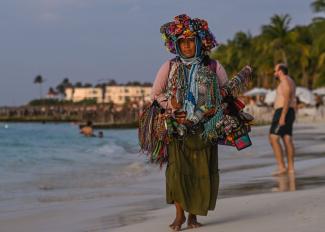Respectful tourism
Mexico must include its indigenous population in the tourism sector
 picture-alliance/NurPhoto/Artur Widak
picture-alliance/NurPhoto/Artur Widak
For centuries, the indigenous peoples of Mexico have inhabited areas with a great biological and cultural diversity, which today are quite often popular tourist destinations.
The Mexican constitution recognises the indigenous peoples. Nevertheless, they are confronted with numerous problems – above all with the fact that in practice they have only limited rights over their territory or that its self-determined administration is not effectively guaranteed. Currently, the areas inhabited by indigenous peoples in Mexico are being transformed by the overexploitation of natural resources in connection with transnational mining companies, agricultural expansion and, not least, tourism.
Tourism megaprojects such as the Tren Maya are part of the problem. Its aim is to bring tourists to the Riviera Maya and back again, offering economic prospects to some of the country’s poorest communities. The project is almost finished. Once completed, it will run through 34 stations in a 1,554 kilometres loop, including some of Mexico’s most famous tourist destinations such as Cancún, Tulum and Palenque.
Many activists and indigenous organisations reject the government’s flagship project. From the outset, indigenous peoples were not adequately consulted, which is why it is argued that free, prior and informed consent is lacking. The construction has not only damaged the natural resources in its course but has displaced indigenous people from their territories as well.
Tourism is furthermore leading to profound changes in social dynamics, including the increasing abandonment of indigenous languages and traditional occupations such as beekeeping. The social divide is also widening as not all people have access to the economic benefits of tourism and decent work.
Meanwhile, some indigenous movements want to defend their territories. A recent case is that of the Wixárika, Náayeri, O‘dam or Au‘dam and Mexikan peoples, who in 2022 submitted a proposal for a decree from the Mexican president to recognise and protect their sacred sites and pilgrimage routes. The decree, which was drafted by the authorities of the indigenous peoples with the support of the federal authorities, was signed by the Mexican government in August 2023. Therefore, these areas should not be affected by economic or tourist activities.
Drug tourism
However, the sacred sites of the Wixárika communities are still endangered – mainly due to drug tourism. The Wixárikas or Wixaritari live in the ranges of the Sierra Madre Occidental, mainly in the states of Jalisco, Nayarit, Durango, Zacatecas and San Luis Potosí. Every year, the Wixaritari make a pilgrimage of several hundred kilometres through the desert of San Luis Potosí. The pilgrimage also includes the search for peyote for their ancestral ceremonies.
Peyote – or hikuri – is an endemic and psychoactive plant that has sparked the curiosity of tourists. This plant is sacred to the indigenous people, as it is a way to connect with their ancestors and regenerate their soul. Although the peyote plant is under special protection according to Mexican Norm 059, it has declined due to illegal trade and excessive demand. It is estimated that the peyote population has decreased by 40 % in places frequented by tourists.
Not only are regulations needed to protect the natural livelihood of peyote. It is also necessary for the Wixaritari families to be able to opt for tourism models that preserve indigenous rituals.
Part of the tourism landscape
Overall, indigenous communities play an important role in Mexico’s tourism. Many of them participate in the tourism industry by selling and marketing their handicraft products, music, dances, ceremonies and regional cuisine.
Craft activities in particular have become a means of self-employment. According to the National Fund for the Promotion of Handicrafts, it is estimated that more than 1 million people make a living from selling handicraft products – although often from hand to mouth. The artisan sector was one of the sectors most affected by the Covid-19 pandemic. The closure of markets, especially tourist ones, has reduced the sources of income of thousands of families and increased their vulnerability.
The revival of the artisan economy required the joint work of several organisations. One example of these efforts is ‘Ensamble Artesano’, a cooperation platform that was launched in 2020 in response to the pandemic. This initiative brought together partner organisations and artisan groups from various parts of Mexico. By 2023, it had already generated a direct economic benefit of more than € 2.7 million for more than 5,600 artisans. The vast majority of them (71 %) are indigenous. This initiative is still in operation.
Artisan cooperatives provide access to formal markets that are otherwise difficult for artisans to access. One such example is ‘Jolom Mayaetik’ in the state of Chiapas (‘Maya weavers’ in the Tsotsil language). The cooperative was founded in 1991 in San Cristobal de las Casas and accommodates at least 250 indigenous Tsotsil and Tseltal female weavers. Their designs are based on traditional Mayan symbolism and techniques. Through the cooperative, these women are given access to training in order to adapt their creations to the requirements of official markets.
Community-centred alternatives
Such sustainable and community-based initiatives must be the alternative to exploitative and harmful forms of tourism in Mexico.
Community-based tourism focuses on emphasising traditions and cultural identity. Local people plan and manage the tourism projects to bring visitors closer to their own culture and share their customs and traditions. This community-orientated model aims to distribute economic benefits more equitably while protecting local heritage.
The state of Yucatán is a role model here. In its six tourist regions, there are a large number of cooperatives and social and family businesses run by Mayan communities. These companies develop tourism experiences and products. One example is the cooperative association ‘Co’ox Mayab’ (‘Let’s go to the Maya region’). Co’ox Mayab was founded in 2015. Today, it comprises nine social enterprises dedicated to community-based tourism.
In 2023, the Secretariat of Tourism Development of the State of Yucatán, UNESCO in Mexico, Airbnb and Co’ox Mayab launched a capacity-building programme for community-based tourism. The aim of this collaboration is to strengthen Mayan communities as owners and mediators of their ancient culture. To this end, groups, collectives and tourism cooperatives were trained in heritage management, sustainability, tour development and other areas.
Mexico’s indigenous peoples
According to statistics from the 2020 Population and Housing Census, there are 23.2 million people in Mexico who identify as indigenous. According to official figures, they are divided into 71 ethnic groups. This corresponds to 19.4 % of the total population aged three years and older.
Sixty-eight indigenous languages are spoken in Mexico, which are divided into 364 variants. The most widespread are Nahuatl (22.4 %), Mayan (10.5 %) and Tseltal (eight percent). Of the total Mexican population, only 6.1 % speak one of these languages, which corresponds to 7.4 million people. The majority of speakers of indigenous languages (87.2 %) also speak Spanish. Four states in the south of the country account for half of the total number of indigenous language speakers: Oaxaca, Chiapas, Yucatán and Guerrero. This is according to data from the National Institute of Statistics and Geography (INEGI) from 2022.
As a multicultural nation, Mexico recognises the indigenous peoples as „those descended from the peoples who inhabited the current territory of the country at the beginning of colonisation and who have preserved their own social, economic, cultural and political institutions or parts thereof,“ as stated in Article 2 of the Political Constitution of the United Mexican States.
Nevertheless, indigenous peoples continue to face discrimination. A national survey on discrimination published in 2023 found that 28 % of indigenous people aged 12 and over reported being victims of discrimination, while 26.9 % of indigenous people aged 18 and over reported being denied some of their rights. Another study by El Colegio de México on ethnic discrimination in Mexico concluded that discrimination practices are sometimes deeply normalised and appear to be triggered often by ethnic characteristics such as speaking an indigenous language or wearing traditional clothing, among other markers. Against this background, the state has a special responsibility to protect the languages, cultures, customs and traditions of its native peoples.
Pamela Cruz is the Special Projects Coordinator at Comunalia, a network of community foundations in Mexico and Strategic Advisor at MY World Mexico.
pamela.cruzm@gmail.com
